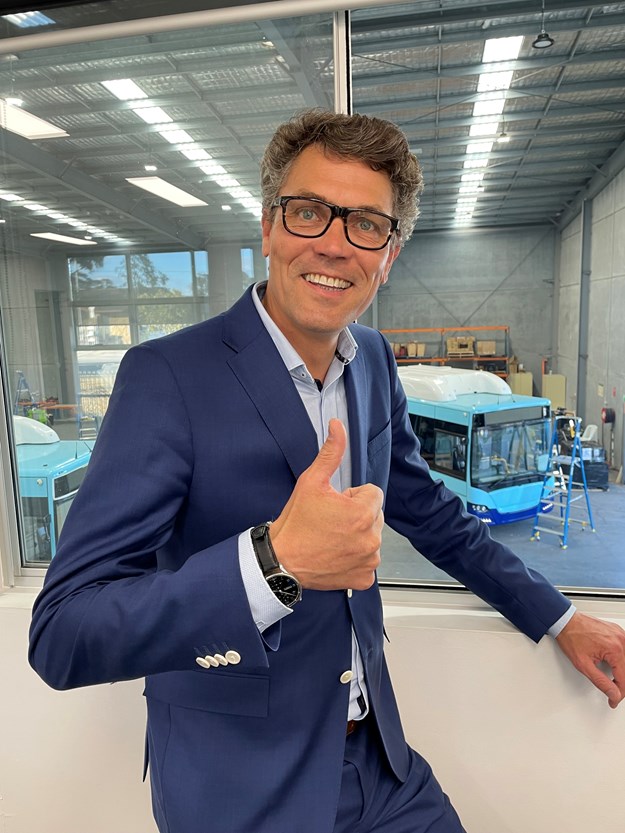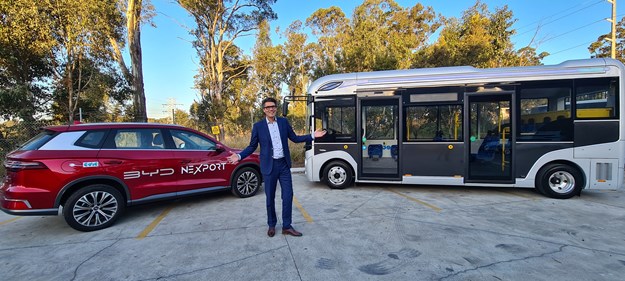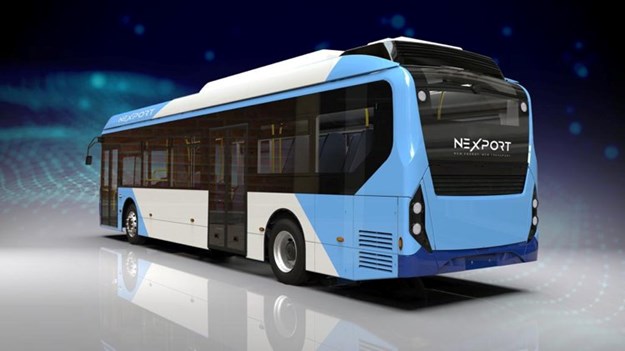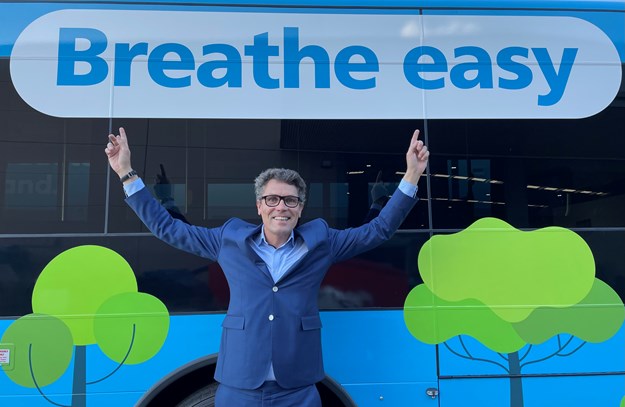INTERVIEW: Bringing years of comprehensive experience with him, founded on a range of roles – most pertinently at Transdev with multiple exec roles worldwide – Michel Van Maanen speaks exclusively to ABC magazine about where we are at with e-vehicles now, what’s on the radar soon and how the full evolution will take place in the near future and beyond.
As the newly appointed CEO of Nexport Mobility, Michel Van Maanen was gracious enough to chat with ABC magazine after arriving in Australia from his native homeland of Holland. The former joint chief commercial officer and chief operations officer (CCO/COO) at Dutch e-bus-making innovator Ebusco, Van Maanen has taken up the role at Nexport to oversee its vision to implement advanced e-mobility products and infrastructure ecosystems throughout Australia, promoting its goal of ‘educating and advising the market’ as the zero-emissions transition here pushes through.
ABC: Hello, Michel. Thanks for taking the time to chat with ABC magazine. Firstly, congratulations on your new role and welcome back to Australia! So … how did you connect with Luke Todd and how was the experience in getting here during a pandemic-stymied Covid world? Was your new role a long time discussed, or was it a faster proposition?
MvM: Hello Fabian, thanks for taking the time and interest in the necessary transition to zero emission transport of people and goods in Australia. When I secured Ebusco in becoming an established company, we also had to set-up Ebusco Australia, so I came across the same people as in my time with Transdev Australasia and discovered your beautiful country again. And, to put it simply, I became homesick and that, combined with the huge opportunities in Australia and clear vision of Luke, attracted me to come back. After discussing with my wife and two young kids, who reacted with a ‘yeeehaaa’, I started the visa process and handed over my tasks in Ebusco on to their fully competent management team… On top of that I was fully convinced all the pioneering work of Nexport in creating the necessary zero emission breeding ground, and relaunching local clean-tech manufacturing in Australia is the right way forward for the Australian vehicle industry. We actually just came out of homeschooling and restricted travel in Europe and were happy to go into the two-week quarantine here, knowing that after that we would finally live in a ‘Covid-free’ environment again. The day we left the hotel on the 26th of June, the government announced the restrictions in Sydney, where Nexport is based. It is a tough one, especially for my kids and wife, and business whilst it remains difficult to have real ‘face to face’ encounters. We have two factories and workshops in Victoria, which I have not been able to visit, for example.
ABC: And is it where you pictured yourself, say, 10 years ago?
MvM: Ten years ago, I was discovering the world of public transport and travelling all over the world (I have been in functions for Transdev in Holland, Portugal, Hong Kong, Qatar, Paris and US) and was always looking for performance improvement on contracts, fleet optimisation and end-customers. So, with that came automatically looking into new technologies like autonomous vehicles, customer applications, MaaS [mobility as a service] and innovative emission technologies for fleets and cars. This means that, within Transdev, we were always aiming to do things differently than our competitors, to be able to win tenders, improve services for our customers or improve the bottom-line. This, with my background in Apple, always motivated me to work on ‘disruption’ and ‘upstream technologies’. So yes, I am not surprised at finding myself in Australia, trying to create and accelerate this new market with the challenges it faces. I think my experience in Europe has highlighted that this transition calls for cooperation in the supply chain from energy suppliers, charger suppliers and the operators, all the way up to cooperation with technology providers and competition. This to make sure we bake this zero emission cake carefully and it doesn’t burn, before we start talking about who gets what piece. It’s a difficult recipe, which needs an integrated approach from all stakeholders to make sure we prepare the ecosystem for handling the deployment of these ‘trams’ (EV buses and cars behave the same like trams and need the same dependent infrastructure), being dependent on the new electric fuel and disruptive handling of operators and end-customers. Education, cooperation, integration and standardisation to result in the successful deployment of the first used cases are the key words that I preach internally and externally. The difference with contract models in public transport, the government’s dominance in that and the lack of incentive programs from the same governments to stimulate [the uptake of] electric cars implies longer deployment and speed of rollout, unfortunately. We would like to stimulate public-private partnerships or commercial consortia to support and accelerate the ‘infra before assets’ mindset. Recently, Nexport submitted its first full turnkey consortium proposition to the Canberra government, where we offer the acquisition of land, build and maintenance of a fully operational bus depot, analysis and connection to the grid, and deployment of chargers and a supporting energy storage solution, secured by a full project deployment plan of the related buses. All this is done by local suppliers and supported by building the buses and related services at a local plant in the region, offered as a total cost of ownership proposition supported by Australia’s biggest bank. As we see this is where the markets, our clients and government stakeholders are heading, we have shifted our organisation from a distributor and build company into a service delivery technology company, focused on operational competences, application competences and technical competences on the assets, the related aftersales and deployment services, supported by applications to manage and measure performance during the complete lifecycle of the car or bus.
ABC: Michel, what is it that you, as a person, uniquely bring to this role? What is it that makes you different that will help make you great at Nexport? What are your best business qualities and what are your flaws?
MvM: I am maybe a bit different than other CEOs, because I believe in a more operational inclusion of CEOs in the day to-day business. I don’t like defending business models if I don’t understand the needs of the people delivering the products or services. I always try to put the responsibilities as low as possible in the organisation and minimise the push from the top. I believe in bottom-up problem solving and want my management team to understand all the processes, opportunities or possible ‘waste’, in order to then support the organisation in solving it themselves, not dictating to them by top-down governance. I think this typically works well in companies that need incremental growth in their journey of becoming an established business, by adapting to changing circumstances but staying flexible and flat. In this market, with disrupting operational demands, we need to make sure our clients and suppliers are guided in the right direction by knowledge floating throughout our entire company and not just the CEO selling a vision to the press. It is a ‘boots on the ground’ approach. Working locally with different maturity levels across the states and supporting this transition at all levels of our company, as well as the related stakeholders as an integrated service team, will make this journey a success. I think my biggest business quality is to energise teams to assure they themselves carry the company forward without being pushed. My flaw is that I am really impatient and get frustrated too quickly when obvious benefits are not embraced and adopted.
ABC: Michel, what got you into buses in the first place? Was it something that you just grew into as a kid, or from your work during the latter part of your career? What’s the ‘bus appeal’ to you?
MvM: After Apple, I came to work in a French company called Veolia Energy, part of Veolia International, consisting of specialised companies in water, waste, energy and later cargo. The cargo division transformed into a public transport company and was later merged with Transdev. I was asked to transfer from the energy division to the transport division to apply the same performance optimisation methodologies all over the divisions. So, for me, the buses/trains/cars were actually just a component in the services we need to procure and manage as part of our total cost of operation and therefore I got to know all of the ins and outs of the specifications, build process, future operational daily management, servicing and contracting of it. And, as Transdev was also one of the biggest taxi and rail companies in Europe, I gathered the same knowledge on cars, vans, minibuses and rail assets. In rail, typically the asset procurement comes much later than the engineering of the ecosystem that supports it and this is a 100 per cent similarity with everything we will encounter now in this zero emission landscape. I also believe that the financing of these sort of transitions will have parallels and we therefore need to start modelling new creative funding models in a broader shared responsibility model between operators, grantors and OEMs.
ABC: How do you see your first year going? What are your ideas and plans? What do you see as the key challenges for the bus and coach industry going forward in both Australia and also globally?
MvM: I just hope, like I said before, that we will see cooperation happening, so that we will establish industry standards and successful deployments from us, the competition and related suppliers in every element of the zero emission ecosystem. I hope charging suppliers (like Tritium and Evie) and energy suppliers will soon find ways to speed up the rollout together with us, to enlarge the electric fuel landscape and take away this blocking anxiety to keep defending fossil fuel usage. Unfortunately, we have not seen many gatherings of the industry happening, but if Covid calms down I would like to see round table sessions happening and not just individual presentations from ‘visionaries’. This industry needs subject matter pushed gatherings where we roll up our sleeves and establish open minded breeding ground meetings, to discuss cooperation and knowledge sharing on servicing our B2G, B2B and B2C clients in a seamless journey towards brighter, cleaner and more silent cities. Nexport CARES (Clean, Accessible, Reliable, Emission-free and Safe) about the transport of people and goods. The challenge for the vehicle industry, in my humble opinion, is to transform from a commodity supplier to a service provider, where the new assets cannot be simply handed over, like in the past, to any client expecting them to just implement or use it as before.
ABC: What are your views on alternative fuels for buses? How is the connection to Foton going? How did they come about and why?
MvM: As we are basing our organisation around the delivery competences in the zero emission ecosystem, Foton has, like other current and future car, van or bus OEMs, made the logical choice to choose Nexport to represent them in sales, engineering, building, deployment, aftersales and parts distribution for hydrogen and electric buses for the coming years. With Foton, we know we have found the right partner in bringing Australia the experience of the hydrogen ecosystem, which for us is a solution in specific states or regions where it makes sense logistically or in terms of green availability. With Neil Wang as the leader in our Foton product line, being the former CEO of Yutong we gained a ‘green world of knowledge’ as he has worked on multiple used cases in this field. Neil is also using his experience to support the build of our clean-tech manufacturing plant in Moss Vale, where we will create more than 100 jobs over time, to start local production of EV buses and (logistic) trucks with an 18.000 square metre production capacity, to live up to our statement: ‘Relaunching local competences and create the future jobs needed for Australia to stay ahead of its zero emission ambitions’.
ABC: Nexport has strong connections to BYD, of course, plus Gemilang here from a body point of view thus far, plus it has just announced a partnership with ADL. Is that where it ends or is their scope for Nexport collaborations with other OEMs?
MvM: Nexport has always positioned itself in the middle of the mobility landscape and, as our clients are greenifying, they are looking into all solutions to reduce their carbon footprint, so we are talking to OEMs across a wider range to provide the market with logical green choices on cars, vans, (delivery) trucks and buses, together again with the related assets and services to make these assets functional. And, to be clear: the potential newcomers are not looking for a simple distribution model, but the future models we bring to the market will always be complemented by the full cycle of local (re-) engineering, technical analysis, chargers, energy provisioning, deployment and lifetime aftersales and parts supply. ADL fits that profile, like others we talk to, as ADL also has a broad experience overseas in making sure a bus is delivered in a broader spectrum of supporting assets, applications and services. As you might have seen quite prominently all over social media, we are also offering end-customer products via EV Direct [in Australia], which will change car use in Australia for individual owners, fleet-managers for corporates and current and new ‘pay per use’ models. We think corporates, for example, will be asked to lead by example with their corporate mobility policies for their employees, management and parking facilities to reinvent and rethink the way people come to work (shared mobility?), service cars and related amenities on the job to reduce ‘miles on the road’. Also making sure people are healthy and fitter could increase green bikes and pedestrian solutions. Nexport is using a green resultancy methodology to broaden the scope of green behaviour and hopes to lift the awareness in analysing and recommending improvements for these business, including current clients, stakeholders and governments;, via the idea of ‘improve the world; start local’.
ABC: To what extent do autonomous e-buses play a part in Nexport’s public transport e-mobility plans here? Is that something we would see within the next, say, two years or is that tech (from anyone) still on hold until greater government assistance is shown towards charging infrastructure rollout; 5G-driven (EMF radiation emissions concern?) IoT inter-vehicle communication advancement; plus traffic hazard liabilities and safety legalities are addressed and formalised?
MvM: I have always stated that before anything autonomous will hit the road you need to control electric mobility to the full extend first. As electric assets need real time full control and management to assure range, charging and safety control on the batteries we need to develop standardisation on communication between the different vehicles and assets first. That needs a lot of work, 5G support and secured management network control, with cooperation between the different suppliers. In public transport they have been struggling with this for a long time, because it means a lot of data mining and data management, which then needs to be based on agreed definitions between stakeholders. If this overlaying application set and data control can be managed properly and daily operations (the operational control centre) can manage this in a predictive way, we can go to the next step, which, in my view, will first be an automated depot that can then be used for autonomous buses to navigate and charge around the depot. Then, in the morning, when drivers start their routes, they get appointed a bus digitally, geofencing will let them know where the bus is stationed and inside the bus they will get their routes and rosters. The bus will be fully charged (example: Rocsys EV charging automation), washed and ready to go. Like I have tried to explain above, Nexport believes the way to go forward is ‘infra before assets and supported by integrated applications’. For EV bus, truck and car applications (including transport on demand and MaaS) it is always about two major key performance indicators; uptime (availability) and patronage/load. So, how reliable is the application of the vehicle and the supporting assets and what load or number of people does it need to carry? On those two we need to find the efficiency to reduce the carbon footprint; the right number of vehicles, the right size of vehicle and the related infrastructure to support the reliability, managed by the right applications to continuously improve the ratios between occupancy (load and cargo) and assets. When this is the mindset, we can really start looking at total cost of operation and don’t overspend when not needed. The second largest investment by a consumer is a car and it is not used for 96 per cent of its lifecycle. It can carry four people and the average occupancy is 1.2 and 50 per cent of every city is a carpark. In public transport a bus can carry 65 people in Australia but the average occupancy is eight. We can do better than that. A lot to do, and Nexport is ready. Cooperate and think different…
ABC: Thanks so much for your time. Do you have any final words about Nexport’s vision to facilitate e-mobility in Australia and what needs to be done to overcome key challenges?
MvM: I just sincerely hope we start seeing mobility as a factor of critical elements to integrate and not as a sum of individual services. Nexport sincerely offers cooperation and an open attitude to create future jobs, help the industry transform, support more liveable cities and just make this world a better place to live and work. I also want to thank you, Fabian, in showing interest in this inevitable transformation of the industry and hope to see more ‘future technology companies’ appearing in your great magazine and online platform.
TRIVIAL PURSUIT
1. SONG STUCK IN YOUR HEAD RIGHT NOW…
A song called ‘Le vent nous portera’ by Noir Desir – It’s a French song and it means: ’The wind will carry us’
2. LAST GREAT PLACE YOU VISITED…
Balmoral Beach in Sydney, close to home, because we cannot travel for the moment
3. A FAVOURITE DISH…
A nice chicken sandwich from Oporto, close to our plant in Glendenning where I work every day
4. A FAVOURITE DRINK…
A nice Australian red wine called “Pepperjack”, which I drink after another day of working with great colleagues
5. IF YOU COULD CHANGE THE WORLD YOU WOULD…
Balance out the big difference between rich and poor and make the future of our planet and the next generation a top priority
6. SOMETHING THAT YOU LEARNED ABOUT YOURSELF TODAY…
Reflect more often, and this interview made me do that
7. THE ONE THING YOU CAN’T LIVE WITHOUT IS…
My beautiful wife, Laura, my son, Adem, my daughter, Levi and my MacBook 🙂
8. YOUR MOST EMBARRASSING MOMENT IS…
Writing an application letter long ago where I started the letter with “Dead Steve”, because of a typo (the letters ‘r’ and ‘d’ are really close to each other on the keyboard) and only found out during the interview!
Photography: courtesy Nexport / True Green





.jpg)




.jpg)